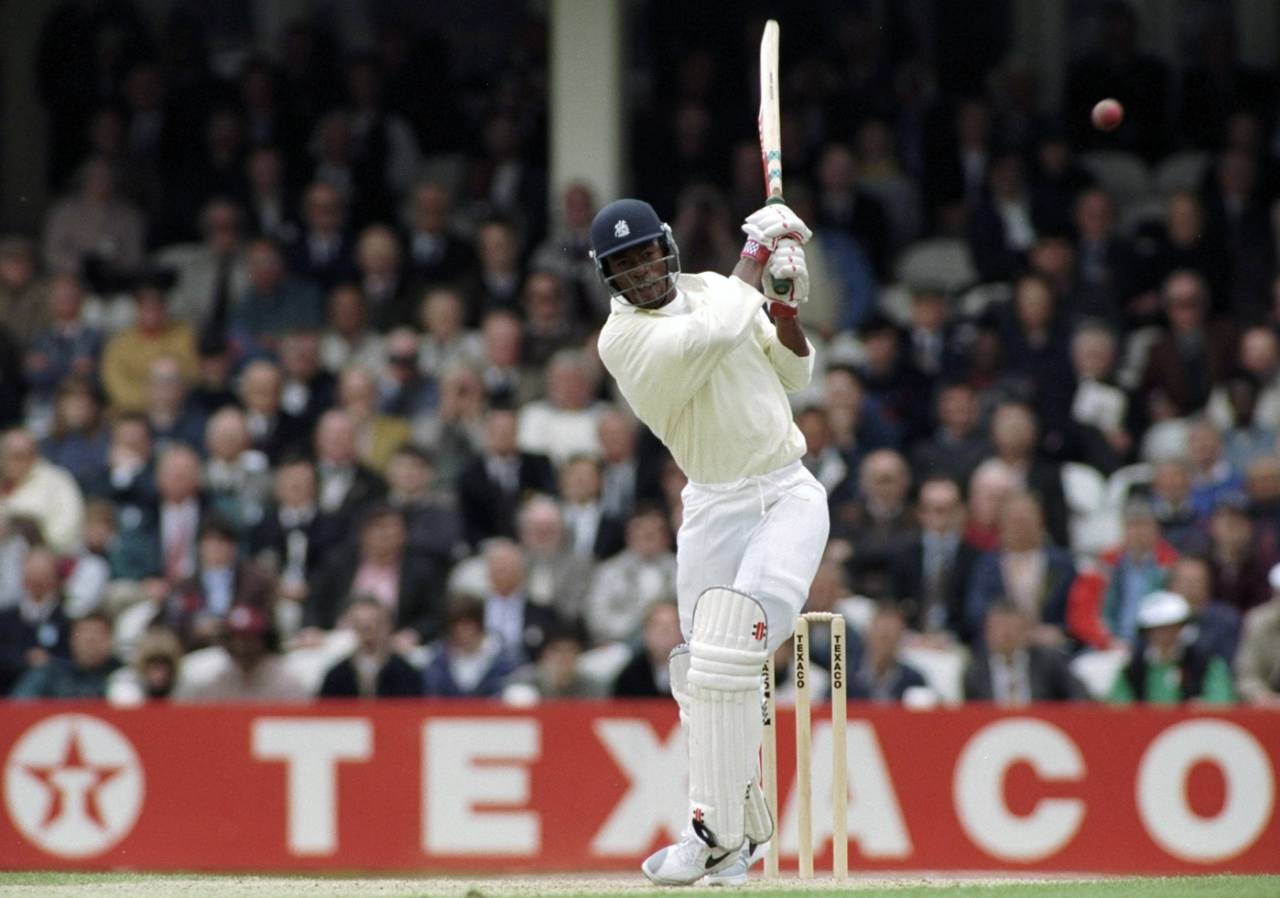Murder and mysterious cricket footage
The curious case of Test match footage used in a TV crime drama
Jonathan Wilson
16-Dec-2013

Chris Lewis: body double for a murder victim • Getty Images
A man has a row with a woman. He chases her out of his cottage and as she climbs into her car, she screams at him to go back to his wife. She drives off and he returns to the flat. He goes to bed. A little later a masked figure tips petrol through the letter box, then throws in a match. Noxious black smoke billows through the cottage and, although the fire soon goes out the man is killed. It later turns out he is the England batsman Kenneth Waring, fresh from scoring a Test century against Pakistan at Lord's the previous week.
This is the misleadingly titled "Playing for the Ashes" (nobody burns to death; nobody plays Australia), episode one of series two of the Inspector Lynley Mysteries, based on the 1995 Elizabeth George novel of the same name. There will, I should warn you, be spoilers ahead, although frankly nobody au fait with the immutable crime drama rule of the time, that the murderer will be played by the most famous actor involved who isn't a regular in the series, should be in any doubt from the off who was responsible.
The instinct when cricket is a theme in television drama is to cringe behind the sofa, but this isn't too bad. There are a couple of slightly odd-sounding, forced phrases as Lynley and his sergeant, Havers, discuss his love of the game, but Lynley just about gets away with it because his poshness and emotional repression lead him to speak fairly strangely anyway. The only real duff note comes when Lynley visits Waring's England team-mate Hugh Patten and interrupts a net session that seems to be taking place in the corner of a school playing field.
Waring (Mark Brighton), it turns out, lives an emotional life just as complex as that of the cricketers in the Ted Dexter thriller, Testkill. He is in the process of getting divorced from his wife (Ruth Gemmell at her whiniest worst), with whom he has three children, and is having a fling with his agent, who happens to be Patten's wife (Clare Swinburne). He also has an odd relationship with Miriam Whitelaw (Phyllis Logan), an older woman who is his patron and a mother figure, and is fairly evidently in love with him.
The cricket action is kept to a minimum, but proves decisive. Lynley, being a busy policeman, hasn't had time to watch much of the series, but decides the best way to solve the case is to settle back in his office with a stack of videos of that summer's Tests. In the first clip only one ball is seen.
Later on, we see Waring clouting a couple of boundaries. It's clearly genuine footage intercut slightly clumsily with Waring's reactions - which of course then makes the real mystery not who killed him, but which game the footage came from.
The bowler taking the wicket is fairly obviously recognisable as Wasim Akram, but I confess the batsman puzzled me. The boundaries provide further clues. The right-arm bowler clearly isn't Waqar Younis, so I worked out pretty quickly it was Aaqib Javed, which placed the series to 1992. I then took the easy way out, and asked the journalist Rob Smyth, a man who is essentially a 20-year catalogue of Test footage in human form.
Gratifyingly, he was puzzled at first as well, although for far more sophisticated reasons than me. "It's Chris Lewis," he said. "It's his stride. But he was only ever lbw once to Wasim in international cricket and it didn't look like that." He was right: it came at The Oval in 1992 and it looked like this.
So what was going on? The clue actually comes in Lynley's reaction. Waring is struck outside the line of off stump to a ball nipping back from Asif Khan (Wasim). The umpire, David Shepherd, raises his finger and Christopher Martin-Jenkins, commentating, seems quite happy with the decision even though the natural angle of the left-armer makes it unlikely to have jagged back far enough. Lynley, rightly, murmurs, "That was never out." And indeed, it wasn't: Shepherd must in real life have given it not out and the footage of him raising his finger is taken from another dismissal.
Watching Waring clubbing his century later, Lynley is struck by the fact he sees to derive little pleasure from it and deduces he has been match-fixing, giving his wicket away cheaply, before "the sportsman in him got the better of him". It later turns out Patten's wife has lured him into it and the murder is a terrible case of mistaken identity as Whitelaw, thinking Patten's wife would be alone in the cottage, tries to kill her to save Waring. But that doesn't explain the terrible lbw: if that was match-fixing, it means Shepherd (and CMJ?) was in on it as well.
But the real oddity is the intersection with real life. The footage is from 1992, but the series was broadcast in 2003, three years after the real-life Chris Lewis had retired from county cricket, saying he'd been driven out after alleging three of his England team-mates had taken money to throw games (claims that were never substantiated).
Five years later, of course, he was arrested at Gatwick Airport and subsequently jailed for 13 years for smuggling cocaine. Still, better than choking on toxic smoke meant for somebody else.
Jonathan Wilson writes for the Guardian, the National, Sports Illustrated, World Soccer and Fox. He tweets here